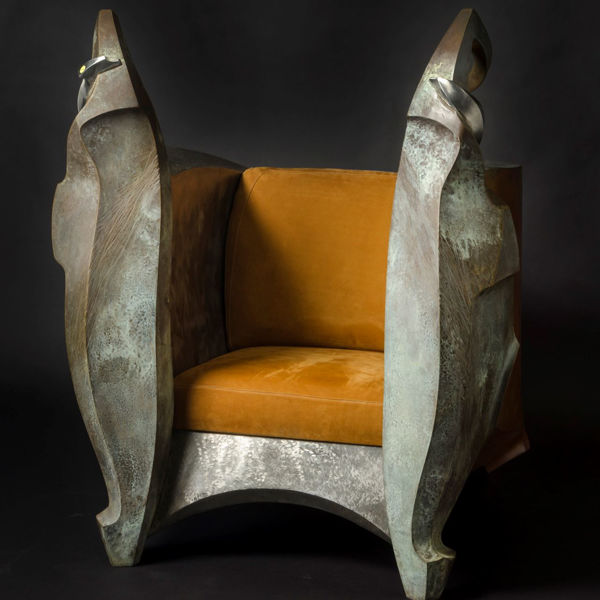Ceramics
Title: Park Forest
Melchart’s use of process and gestural ‘acts’ open interpretations into the fabric and structural beauty of a material, the artist often seeking a revelatory moment of chance discovery which — on subsequent reflection — can uncover truths about the person as well as the act and the art. “Park Forest” is a piece formed from action often returned to by Melchart; a slab of stoneware heated until hidden weaknesses crack under stress, then decorated or refurnished based upon them. Melchart posits that the resulting set of hairline fractures — and therefore the resubmitted form — is a result of chance and yet also not, the possibility of a fault’s fruition having always been embedded in the clay at an elemental level, set to wait for the artist’s .
Title: Peaches La Tour
Early glazed and painted ceramic sculpture of a fish on a plate, Seattle, WA, 1970s; Signed; Total: 20" x 14" x 5"
Title: Peaches n Napkin
Trompe-l’oeil ceramics from Tarantino, whose attention to detail brings a remarkable state of life and energy to an otherwise well-trodden path of still-life arrangement. The artist sees food as the facilitator of primary human engagement and social interaction, the preparation a ritualistic and emotionally rigorous event — and the ceramic sculpture aims to immortalise the action and become a symbolic token that serves to highlight individual roles in art exchanges.
Title: Pink Gloop
Brian Rochefort’s unedited ‘gloop’ sculptures represent a relentless material romance. These sculptures represent a blending of old and new ceramic techniques. Made with ceramic, glaze and automotive paint.
Title: Place Setting XIII
Ceramic and Mixed Media Provenance: Tory Folliard Gallery, Milwaukee, Wisconsin
Title: Platter
This wood-fired plate is unusual in the amount of activity that has taken place. Voulkos has torn off most of the collar on this plate leaving only four portions behind. One part of the plate has been torn-off and replaced; plugs of clay have been inserted into holes and other holes are edged in white slip. The actual drawing on the plate is a cross between cave markings and an astrological map.
Title: Play Time
Bogard’s androgynous ceramics explore sexuality in loose, lucid figurative and iconographic profiles. Utilising symbols that convey a regulatory ‘feminine’ quality — flowers, young animals, soft curving lines — the works unshackle themselves from stereotype through an act of reclamation. ‘Play Time’ scores an act of love in a reflexive, vaguely unsettling model, the disposition of the insects at odds with the distinctly human interplay of body in embrace and choice of furniture. The artist attempts to alter “rules of engagement” with her sculpture, stripping away assumptions of gender with the typically amorphous or asexual insect.
Title: Porcelain Bear
Thai sculptor and ceramicist Srivalasa finds a spiky humour and spirit in his ceramics, particularly notable in the pop anthropomorphic entities that radiate a warmth and whimsical quality, mostly crafted over a two year residency in Jingdezhen. ‘Porcelain Bear’s decorative fetish-wear finds no contention with affection, the vivid black (plausibly leatherlike) attractively striking against the polished white ceramic and prompted “blue onion”-style tattoo creating a particularly attractive work. The bears’ receptive stance is particularly amplified with the elaborate shaggy adornment.
Title: Powermatic
'Disjunction No. 3' typifies Montgomery’s interest in junk, detritus and ruin as monument, the outpourings of his practice a miasma of industrial, apocalyptic or apocryphal degradation in clay form. The complexity of technology evades and fascinates the artist, but he also finds it something to distrust — and the decision to adroitly shape its likeness in clay and then to shatter its integrity speaks of a desire to refigure its position within the human condition.





































